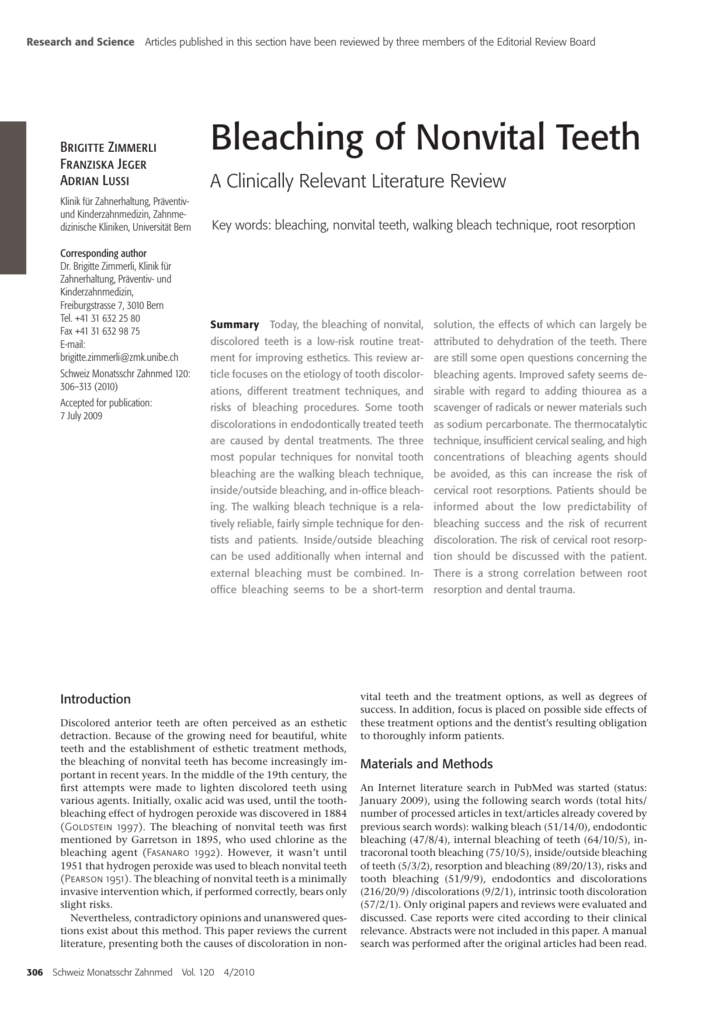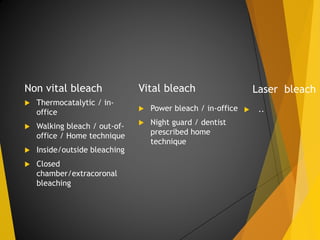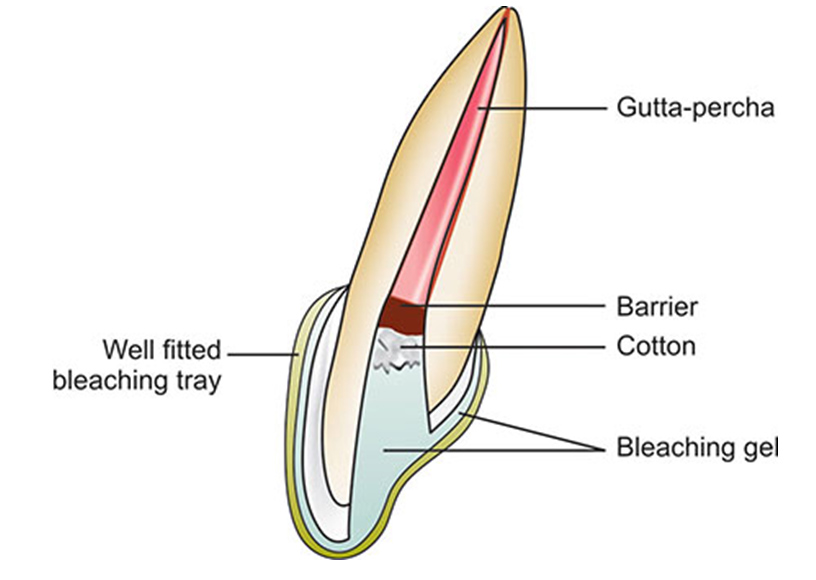walking bleach technique
Not intended for use in traumatized teeth any sign of cervical resorption or after previous multiple. Web of Science Journals.
With the thermocatalytic method various forms of heat arc used to speed up the release of oxygen.

. Given by Nutting and Poe. 182 Walking Bleach Technique 1. The cervical barrier is a standard of care in internal.
A material is placed over the top of the root canal filling to protect the tooth from the bleaching agent. Nutting and Poe in 1963 modified this technique by rep lacing water with 30 hy drogen peroxide and new technique was called walking bleach. Ble way to bleach discolo red non vital teeth 1.
This technique is a conservative alternative to a more invasive esthetic treatment such as. Opalescence Endo non-vital whitening gel is formulated specifically to whiten endodontically treated discoloured teeth using the walking bleach technique. They replaced water by 30 hydrogen peroxide which is called the walking bleach technique.
However sodium perborate has been classified as carcinogenic mutagenic and toxic for reproduction by European Union legislation. Several studies showed that bleaching can be considered effective when there is a change of at least 5 ΔE units. The tooth involved is usually non vital and should be endodontically treated.
Among tfie bleaching techniques the walking bleach technique with sodium perborate associated with water or hydrogen peroxide stands out because of its esthefic re- sults and safety. The bleaching agent is left in the tooth so that it can function as walking bleach until the next visit. Walking bleach is a bleaching procedure performed at a dental clinic.
This is the general procedure for the walking bleach technique. Once Opalescence Endo gel is delivered to the pulp chamber it should be sealed with a temporary cement and left in the tooth for one to five days. The majority of cases can be successfully managed using the technique described below and without the need for pre-bleaching endodontic revision Figures 1a and b.
To summarize in the walking bleach technique the root filling should be completed first and a cervical seal must be established. Easy to place inside pulp chamber. Tooth discolouration as a result of intrapulpal hemorrhage ie.
The purpose of this study was to compare the in vitro sealing capacity of five materials each used as a temporary sealing agent for the walking bleach technique. Spasser introduced the application of sodium perborate and water in the pulp chamber of root canal-treated tooth to bleach the discolored nonvital teeth in 1961. Another name of Walking Bleach is Intracoronal bleaching Used in non vital endodontically treated tooth to remove tooth discoloration.
It was introduced by Spasser and later. Made bleaching tray keeps the bleaching agent in and around the tooth. The walking bleach technique is performed by application of a paste.
Its use is therefore prohibited since April 2015. Walking Bleach Technique Most common technique Sealing of the endodontically treated root canal with RMGI or GI Placement of the bleaching material in the pulp chamber Access cavity sealed with temporary restoration and recall after 2-7 days 24. Official Character Book 3 UNMASKED.
Before the placement of bleaching gel Opalescence Endo into the tooth the so-called pulp chamber inside the tooth needs to be cleaned with a drill. Intra-coronal bleaching with Walking Bleach technique is a widely accepted procedure when it comes to t he treatment of such an anterior discolored teeth. Regardless of the technique used internal tooth bleaching is an effective procedure with good aesthetic results in the treatment of non-vital teeth.
The walking bleaching technique with 35 hydrogen peroxide and 37 carbamide peroxide results in constantly increasing levels of RANK-L and IL-1β in the gingival crevicular fluid around the bleached teeth through one month postbleaching. Bleaching gel is then placed inside the pulp chamber and the tooth is covered with provisional filling substance. A hole is made into the space inside your tooth.
Journal of Esthetic and Restorative Dentistry Volume 1 6 Nov 1 1989 Read Article Download PDF Share Full Text for Free 3 pages Article Details Recommended References Bookmark Add to Folder Cite Social Times Cited. This is associated with a chronic process within the periodontium apparently of unknown behaviorthat is. Traumatic dental injuries pulp necrosis pulp tissue remnants after endodontic therapy internal resorption etc can be effectively and safely corrected with walking bleach internal bleaching technique.
All teeth received traditional biomechanical root canal instrumentation after which the walking bleach agent was placed in the pulp chamber space. Official Character Book 2 MASKED. Vaseline is applied to the lips and a rubber dam is applied to the tooth being whitened.
Discoloured root-filled teeth can be successfully managed with the inside outside bleaching technique. The primary difference between the two methods is the way in which nascent oxygen is released from the chemicals. The bleaching agent should be changed every 37 days for up to 34 visits 20.
A modified wali. The bleaching gel needs to be replaced several times to achieve the desired results. The Walking Bleach Technique Putter Harvey.
1 In 1963 this technique was modified by Nutting and Poe. 19 Our results showed that in four sessions using the walking bleach technique and up to one month after treatment there was a change of 1548 517 of ΔE for group 1 and 1402 485 of ΔE for group 2 which was highly effective. The two basic techniques are the thermocatalytic method and the walking bleaching techniques.
Over the past decades the walking bleach technique using sodium perborate was considered a safe and effective method to bleach nonvital discolored teeth. The walking-bleach and the combined techniques were both effective at the end of the treatment obtaining similar aesthetic results. This is a Category page for techniques used in Bleach.
Internal bleaching procedures such as the walking bleach technique can be used for whitening of discoloured root-filled teeth. Opalescence Endo non-vital whitening gel is formulated specifically to whiten non-vital endodontically treated teeth using the walking bleach technique.

An Effective Bleaching Technique For Non Vital Discoloured Teeth In Children And Adolescents Semantic Scholar

Pdf Non Vital Tooth Bleaching Techniques A Systematic Review

Intracoronal Bleaching Of Nonvital Teeth Pocket Dentistry

Bleaching Of Nonvital Teeth Swiss Dental Journal Sso Mit

Pdf Non Vital Tooth Bleaching Techniques A Systematic Review Semantic Scholar

Bleaching Of Discoloured Tooth Ppt

An Effective Bleaching Technique For Non Vital Discoloured Teeth In Children And Adolescents Semantic Scholar

Bleaching Of Non Vital Tooth Semantic Scholar

Pdf Walking Bleach With Sodium Perborate Tetrahydrate A Safer Material And Method

Dos And Donts In Dentistry Walking Bleach Technique

Kids Are Using Too Much Toothpaste Bad Dental Health Habits Delta Dental Of Arizona Blog Tips For Healthy Teeth Happy Smiles Dental Health Health Habits Mouth Health

Non Vital Internal Bleaching Prestige Dental Care Com My
Intracoronal Bleaching Of Nonvital Tooth Teeth Whitening

Pdf The Efficacy Of Walking Bleach Technique In Endodontically Treated Teeth Case Report






Comments
Post a Comment